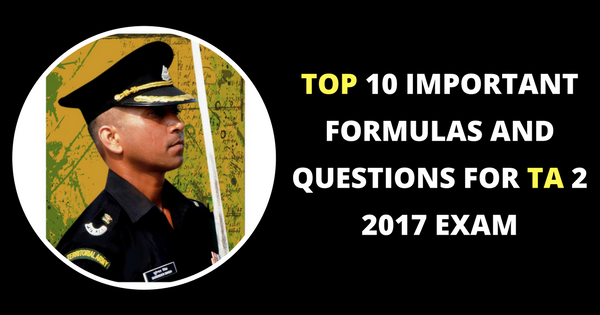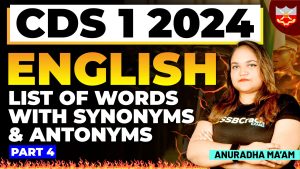We recommend you to go through the below given formulas and numerials that we have prepared. Remember them with your heart and mind, it is very necessary that you score good marks in numerical ability section of TA exam.
Top 10 Important Formulas and Questions For TA 2 2017 Exam

1) Simplification:
- Rule of ‘BODMAS’: This BODMAS rule depicts the correct sequence in which the operations are to be executed, so as to find out the value of given expression. Full form of BODMAS is B – Bracket, O – of, D – Division, M – Multiplication, A – Addition and S – Subtraction. Thus, while solving or simplifying a problem, first remove all brackets, strictly in the order (), {} and ||. After removing the brackets, we will use the following operations strictly in the following order: (i) of (ii) Division (iii) Multiplication (iv) Addition (v) Subtraction.
2) Average:
- Average = (Sum of observations/Number of observations)
- Suppose a train covers a certain distance at x kmph and an equal distance at y kmph. Then, the average speed of train during the whole journey is kmph (2xy/x+y)kmph.
3) Percentage:
- By a certain percent, we mean that many hundredths. Thus, x percent means x hundredths, written as x%. To express x% as a fraction: We have, x% = x/100
- To express a/b as a percent: We have, a/b = (a/b x 100)%
- Percentage Increase/Decrease: If the price of a commodity increases by R%, then the reduction in consumption so as not to increase the expenditure is: [(R/(100+R)) x 100]%. If the price of a commodity decreases by R%, then the increase in consumption so as not to decrease the expenditure is: [(R/(100-R)) x 100]%.
- Result on Population: Let the population of a town be P now and suppose it increases at the rate of R% per annum, then: population after n years = P (1+(R/100))n Population n years ago= P/ (1+(R/100))n
- Result on Depreciation: Let the present value of a machine be P. Suppose it depreciates at the rate of R% per annum. Then: Value of the machine after n years = P (1-(R/100)n , Value of the machine n years ago = P/ (1-(R/100)n, If A is R% more than B, then B is less than A by [(R/(100+R)) x 100] %, If A is R% less than B, then B is more than A by [(R/(100-R)) x 100] %
4) Ratio:
- Rule: The multiplication or division of each term of a ratio by the same non-zero number does not affect the ratio. Eg. 4 : 5 = 8 : 10 = 12 : 15. Also, 4 : 6 = 2 : 3.
5) Proportion:
- The equality of two ratios is called proportion. If a : b = c : d, we write a : b :: c : d and we say that a, b, c, d are in proportion. Here a and d are called extremes, while b and c are called mean terms. Product of means = Product of extremes. Thus, a : b :: c : d (b x c) = (a x d).
6) Simple Interest:
- Principal: The money borrowed or lent out for a certain period is called the principal or the sum.
- Interest: Extra money paid for using other’s money is called interest.
- Simple Interest (S.I.): If the interest on a sum borrowed for certain period is reckoned uniformly, then it is called simple interest. Let Principal = P, Rate = R% per annum (p.a.) and Time = T years. Then Simple Interest = (P x R x T)/100
7) Profit and Loss:
- Cost Price: The price, at which an article is purchased, is called its cost price, abbreviated as C.P.
- Selling Price: The price, at which an article is sold, is called its selling prices, abbreviated as S.P.
- Profit or Gain: If S.P. is greater than C.P., the seller is said to have a profit or gain.
- Loss: If S.P. is less than C.P., the seller is said to have incurred a loss.
- Gain = (S.P.) – (C.P.)
- Loss = (C.P.) – (S.P.)
8) Decimal Fraction:
- A decimal fraction is a fraction in which denominator is an integer power of ten. (The term decimals are commonly used to refer decimal fractions). Generally, a decimal fraction is expressed using decimal notation and its denominator is not mentioned explicitly
Examples: 1/10 = .1 , 1/100 = .01
- Conversion of a Decimal into Common Fraction: Put 1 in the denominator under the decimal point and annex with it as many zeros as is the number of digits after the decimal point. Now, remove the decimal point and reduce the fraction to its lowest terms.
9) Compound interest formula
The formula for annual compound interest is A = P (1 + r/n) ^ nt:
Where:
A = the future value of the investment/loan, including interest
P = the principal investment amount (the initial deposit or loan amount)
r = the annual interest rate (decimal)
n = the number of times that interest is compounded per year
t = the number of years the money is invested or borrowed for
10) Arithmetic Series formula
In an Arithmetic Sequence the difference between one term and the next is a constant.
say: {a, a+d, a+2d, a+3d, … }
We can write an Arithmetic Sequence as a rule:
xn = a + d(n-1)
(We use “n-1” because d is not used in the 1st term)
.
Territorial Army 2 2017 Exam Mock Test Series
10 Questions You Must Read Before Writing Territorial 2 2017 Army Exam
1) Look at this series: 36, 34, 30, 28, 24, … What number should come next?
A. 20
B. 22
C. 23
D. 26
2) In these series, you will be looking at both the letter pattern and the number pattern. Fill the blank in the middle of the series or end of the series.
SCD, TEF, UGH, ____, WKL
A. CMN
B. UJI
C. VIJ
D. IJT
3) Look carefully at the sequence of symbols to find the pattern. Select correct pattern.

A. 1
B. 2
C. 3
D. 4
4) Analogy- Poles : Magnet :: ? : Battery
A. Energy
B. Power
C. Terminals
D. Cells
5) Directions: Choose the figure which is different

A. 1
B. 2
C. 3
D. 4
6) If x = 4, y = 12 and x α y, then
A. 4y = 3x
B. x = 3y
C. y = 3x
D. 4x = 3y
7) A prime number N, in the range 10 to 50, remains unchanged when its digits are reversed. The square of such a number is
A. 1936
B. 1089
C. 484
D. 121
8) The first Muslim ruler who introduced a standing army was:-
(a) Al-ud-din-khilji
(b) Iltutmish
(c) Balban
(d) Firozshah Tughlaq
9) The upheaval of 1857 was first described as the war of independence by:-
(a) Jawaharlal Nehru
(b) Bal Gangadhar Tilak
(c) V D Savarkar
(d) Lala Lajpat Rai
10) ENGLISH COMPREHENSION
Read the following passage carefully to answer the questions given below (10 Marks)
Every breath came wheezing out of me like an asthmatic in trouble. My legs felt like lead and though it was cold and windy, my clothes were though it was cold and windy, my clothes were damp with sweat. “Only 30 minutes more,” said Qasimwani my much older and fitter forest guide and friend. What he never added was that the kilometre long trudge to our next nest-stop Sangargulu in upper Dachigam 4,000 metres above sea-level was almost straight up as he himself does’nt find the climb difficult. We had walked for five straight hours, starting from the lower reaches of Kashmir’s Dachigam National Park roughly following the route of the Himalayan glacier-fed Dagwan river up to its source. I had come to know and love this crystal mountain stream well. It sustained an incredible diversity in abundance of flora and fauna a nature coupled with animals before pouring its musical aqua into Srinagar’s famed Dal Lake; without the Dagwan, the health and economy of Srinagar would beat a risk. I thought to myself as I paused, frequently to take in the sight of sanctuary of black bears, yellow throated mantels, Dachigam’s endangered Hangul deer, Hanuman Langurd monkeys and the throb of buzz of bees and shrills of birds and multi-hued insects all around. And my word. The birds! Red billed blue magpies, redstarts , orioles and woodpeckers combined with warblers to set up an orchestra providing a welcome mist-laden breather from the leg-after-leg goat trek hike that stole my breath away. Like leaves of a book, every 1000 metres or so new stories unfolded as the national canvas changed. Verdant which are green and flourishing Chinar, Oak and Walnut gave way to higher elevation forests of silver Birch and Conifers where spiders and sawscaled vipers shared silent space in the dark root hollows of ancient trees. Above the treeline amidst Junipers and one of our planet’s most spectacular wild flower fields in Sungargulu, I momentarily caught my breath, lay down and slept for a while.
The 141 square kilometres Dachigam was a second home away from our Bombay home till the mid 1980’s. Back then Dachigam had its problems but they were different excess grazing, wood cutting, a sheep farm and trout hatchery in the heart of the park that we wanted out. Today there is a deep hollow, a pain. It is the relentless destruction of all that makes Kashmir. Kashmir beneath the picture postcard insets are deforested slopes, polluted rivers and lakes, and hard evidence of relentless march of climate change-much of it is the result of human interference resulting in melting glaciers, the retreat of junipers, early and late flowering, nesting and erratic migration. Such fluctuations are destabilizing the ecological foundations of Kashmir.
Is all lost then? Are the hundreds of other Himalayan valleys condemned to a fate worse than death? No, far from it, India as cautious hope can escape the worst impact of climate change if we act purposefully but the public will probably have to force the policy makers to move away from carbon energy and restore the many degraded ecosystems that sequester and store carbon, and buffer us from floods and droughts.
Q Choose the word from the passage which means green and flourishing.
(a) Sangargulu
(b) Verdant
(c) Conifers
(d) Treeline
Q According to the passage what stories unfolded as the author climbed up the Dachigam Sanctuary ?
(a) Of abundance of flora and fauna in nature
(b) Of rare birds
(c) Of Hangul Deer
(d) Of deforestation



















